Multimineral Fingerprinting of Transhimalayan and Himalayan Sources of Indus-Derived Thal Desert Sand (Central Pakistan)
Abstract
1. Introduction
2. The Indus River Catchment and the Thal Desert
2.1. Karakorum Belt
2.2. Ladakh and Kohistan Arcs
2.3. Himalayan Belt and Nanga Parbat Massif
2.4. Thal Desert
3. Methods
3.1. Sampling
3.2. Heavy Mineral Analyses
3.3. Sources of Bias
3.4. Microchemical Analyses
3.5. Amphibole Chemistry
3.6. Garnet Chemistry
3.7. Epidote Chemistry
3.8. Pyroxene Chemistry
4. Heavy Mineral Sources
4.1. Karakorum
4.2. Ladakh and Kohistan Arcs
4.3. Greater Himalaya
4.4. Nanga Parbat
5. Heavy-Mineral Provenance Tracers in Thal Desert Sand
5.1. The Thal Desert as a Quaternary Sediment Sink
5.2. Heavy Mineral Concentration and Provenance Estimates
5.3. The Amphibole Signal
5.4. The Garnet Signal
5.5. The Epidote Signal
5.6. The Pyroxene Signal
6. Conclusions
Supplementary Materials
Author Contributions
Funding
Acknowledgments
Conflicts of Interest
References
- Mange, M.A.; Wright, D.T. Heavy Minerals in Use. Developments in Sedimentology Series; Elsevier: Amsterdam, The Netherlands, 2007; Volume 58, 1283p. [Google Scholar]
- Garzanti, E.; Vezzoli, G.; Lombardo, B.; Ando, S.; Mauri, E.; Monguzzi, S.; Russo, M. Collision-orogen provenance (western Alps): Detrital signatures and unroofing trends. J. Geol. 2004, 112, 145–164. [Google Scholar] [CrossRef]
- Garzanti, E.; Resentini, A.; Vezzoli, G.; Ando, S.; Malusa, M.G.; Padoan, M.; Paparella, P. Detrital fingerprints of fossil continental-subduction zones (Axial Belt Provenance, European Alps). J. Geol. 2010, 118, 341–362. [Google Scholar] [CrossRef]
- Garzanti, E.; Al-Juboury, A.I.; Zoleikhaei, Y.; Vermeesch, P.; Jotheri, J.; Akkoca, D.B.; Obaid, A.K.; Allen, M.B.; Ando, S.; Limonta, M. The Euphrates-Tigris-Karun river system: Provenance, recycling and dispersal of quartz-poor foreland-basin sediments in arid climate. Earth Sci. Rev. 2016, 162, 107–128. [Google Scholar] [CrossRef]
- Mange, M.A.; Morton, A.C. Geochemistry of heavy minerals. In Heavy Minerals in Use. Developments in Sedimentology Series; Mange, M.A., Wright, D.T., Eds.; Elsevier: Amsterdam, The Netherlands, 2007; Volume 58, pp. 345–391. [Google Scholar] [CrossRef]
- Krynine, P.D. The tourmaline group in sediments. J. Geol. 1946, 54, 65–87. [Google Scholar] [CrossRef]
- Morton, A.C. A new approach to provenance studies: Electron microprobe analysis of detrital garnets from Middle Jurassic sandstones of the northern North Sea. Sedimentology 1985, 32, 553–566. [Google Scholar] [CrossRef]
- Morton, A.C. Geochemical studies of heavy minerals and their application to provenance research. In Developments in Sedimentary Provenance Studies; Special Publication 57; Morton, A.C., Todd, S.P., Haughton, P.D.W., Eds.; Geological Society of London Publications: London, UK, 1991; pp. 31–45. [Google Scholar] [CrossRef]
- von Eynatten, H.; Gaupp, R. Provenance of Cretaceous synorogenic sandstones in the Eastern Alps: Constraints from framework petrography, heavy mineral analysis and mineral chemistry. Sediment. Geol. 1999, 124, 81–111. [Google Scholar] [CrossRef]
- Meinhold, G. Rutile and its applications in earth sciences. Earth Sci. Rev. 2010, 102, 1–28. [Google Scholar] [CrossRef]
- Andò, S.; Morton, A.; Garzanti, E. Metamorphic grade of source rocks revealed by chemical fingerprints of detrital amphibole and garnet. In Sediment Provenance Studies in Hydrocarbon Exploration and Production; Special Publication 386; Scott, R.A., Smyth, H.R., Morton, A.C., Richardson, N., Eds.; Geological Society of London Publications: London, UK, 2014; pp. 351–371. [Google Scholar] [CrossRef]
- Malusà, M.G.; Wang, J.; Garzanti, E.; Liu, Z.C.; Villa, I.M.; Wittmann, H. Trace-element and Nd-isotope systematics in detrital apatite of the Po river catchment: Implications for provenance discrimination and the lag-time approach to detrital thermochronology. Lithos 2017, 290, 48–59. [Google Scholar] [CrossRef]
- von Eynatten, H.; Dunkl, I. Assessing the sediment factory: The role of single grain analysis. Earth Sci. Rev. 2012, 115, 97–120. [Google Scholar] [CrossRef]
- Moecher, D.P.; Samson, S.D. Differential zircon fertility of source terranes and natural bias in the detrital zircon record: Implications for sedimentary provenance analysis. Earth Planet. Sci. Lett. 2006, 247, 252–266. [Google Scholar] [CrossRef]
- Malusà, M.G.; Resentini, A.; Garzanti, E. Hydraulic sorting and mineral fertility bias in detrital geochronology. Gondwana Res. 2016, 31, 1–19. [Google Scholar] [CrossRef]
- Garzanti, E.; Limonta, M.; Vezzoli, G.; An, W.; Wang, J.; Hu, X. Petrology and multimineral fingerprinting of modern sand generated from a dissected magmatic arc (Lhasa River, Tibet). In Tectonics, Sedimentary Basins, and Provenance: A Celebration of William, R. Dickinson’s Career; Special Paper 540; Ingersoll, R.V., Lawton, T.F., Graham, S.A., Eds.; Geological Society of America: Boulder, CO, USA, 2018; pp. 197–221. [Google Scholar] [CrossRef]
- Guo, R.; Hu, X.M.; Garzanti, E.; Lai, W.; Yan, B. Magmatic and metamorphic events in Himalaya and Tibet traced by geochronological and geochemical fingerprinting of detrital zircon, monazite, rutile, and titanite. Earth Sci. Rev. 2019, in press. [Google Scholar]
- Garzanti, E.; Vezzoli, G.; Ando, S.; Paparella, P.; Clift, P.D. Petrology of Indus River sands: A key to interpret erosion history of the Western Himalayan Syntaxis. Earth Planet. Sci. Lett. 2005, 229, 287–302. [Google Scholar] [CrossRef]
- Clift, P.D.; Shimizu, N.; Layne, G.; Blusztajn, J.S.; Gaedicke, C.; Schluter, H.-U.; Clark, M.K.; Amjad, S. Development of the Indus Fan and its significance for the erosional history of the Western Himalaya and Karakoram. Geol. Soc. Am. Bull. 2001, 113, 1039–1051. [Google Scholar] [CrossRef]
- Clift, P.D.; Giosan, L.; Carter, A.; Garzanti, E.; Galy, V.; Tabrez, A.R.; Pringle, M.; Campbell, I.H.; France-Lanord, C.; Blusztajn, J. Monsoon control over erosion patterns in the western Himalaya: Possible feed-back into the tectonic evolution. In Monsoon Evolution and Tectonic-Climate Linkage in Asia; Special Publications 342; Clift, P.D., Tada, R., Zheng, H., Eds.; Geological Society of London Publications: London, UK, 2010; pp. 185–218. [Google Scholar] [CrossRef]
- Lee, J.I.; Clift, P.D.; Layne, G.; Blum, J.; Khan, A.A. Sediment flux in the modern Indus River inferred from the trace element composition of detrital amphibole grains. Sediment. Geol. 2003, 160, 243–257. [Google Scholar] [CrossRef]
- Alizai, A.; Clift, P.D.; Still, J. Indus Basin sediment provenance constrained using garnet geochemistry. J. Asian Earth Sci. 2016, 126, 29–57. [Google Scholar] [CrossRef]
- Garzanti, E.; Andò, S. Plate tectonics and heavy-mineral suites of modern sands. In Heavy Minerals in Use. Developments in Sedimentology Series; Mange, M.A., Wright, D.T., Eds.; Elsevier: Amsterdam, The Netherlands, 2007; Volume 58, pp. 741–763. [Google Scholar] [CrossRef]
- Clift, P.D.; Lee, J.I.; Hildebrand, P.; Shimizu, N.; Layne, G.D.; Blusztajn, J.; Blum, J.D.; Garzanti, E.; Khan, A.A. Nd and Pb isotope variability in the Indus River System: Implications for sediment provenance and crustal heterogeneity in the Western Himalaya. Earth Planet. Sci. Lett. 2002, 200, 91–106. [Google Scholar] [CrossRef]
- Alizai, A.; Clift, P.D.; Giosan, L.; Van Laningham, S.; Hinton, R.; Tabrez, A.R.; Danish, M.; The Edinburgh Ion Microprobe Facility (EIMF). Pb isotopic variability in the modern-Pleistocene Indus River system measured by ion microprobe in detrital K-feldspar grains. Geochim. Cosmochim. Acta 2001, 75, 4771–4795. [Google Scholar] [CrossRef]
- Jonell, T.N.; Li, Y.; Blusztajn, J.; Giosan, L.; Clift, P.D. Signal or noise? Isolating grain size effects on Nd and Sr isotope variability in Indus delta sediment provenance. Chem. Geol. 2018, 485, 56–73. [Google Scholar] [CrossRef]
- Clift, P.D.; Campbell, I.H.; Pringle, M.S.; Carter, A.; Zhang, X.; Hodges, K.V.; Khan, A.A.; Allen, C.M. Thermochronology of the modern Indus River bedload: New insight into the controls on the marine stratigraphic record. Tectonics 2004, 23, TC5013. [Google Scholar] [CrossRef]
- Campbell, I.H.; Reiners, P.W.; Allen, C.M.; Nicolescu, S.; Upadhyay, R. He-Pb double dating of detrital zircons from the Ganges and Indus Rivers: Implication for quantifying sediment recycling and provenance studies. Earth Planet. Sci. Lett. 2005, 237, 402–432. [Google Scholar] [CrossRef]
- Alizai, A.; Carter, A.; Clift, P.D.; Van Laningham, S.; Williams, J.C.; Kumar, R. Sediment provenance, reworking and transport processes in the Indus River by U–Pb dating of detrital zircon grains. Glob. Planet. Chang. 2011, 76, 33–55. [Google Scholar] [CrossRef]
- Munack, H.; Korup, O.; Resentini, A.; Limonta, M.; Garzanti, E.; Blöthe, J.H.; Scherler, D.; Wittmann, H.; Kubik, P.W. Postglacial denudation of western Tibetan Plateau margin outpaced by long-term exhumation. Geol. Soc. Am. Bull. 2014, 126, 1580–1594. [Google Scholar] [CrossRef]
- Alizai, A.; Hillier, S.; Clift, P.D.; Giosan, L.; Hurst, A.; Van Laningham, S.; Macklin, M. Clay mineral variations in Holocene terrestrial sediments from the Indus Basin. Quat. Res. 2012, 77, 368–381. [Google Scholar] [CrossRef]
- Treloar, P.J.; Petterson, M.G.; Jan, M.Q.; Sullivan, M.A. A re-evaluation of the stratigraphy and evolution of the Kohistan arc sequence, Pakistan Himalaya: Implications for magmatic and tectonic arc-building processes. J. Geol. Soc. 1996, 153, 681–693. [Google Scholar] [CrossRef]
- DiPietro, J.A.; Pogue, K.R. Tectonostratigraphic subdivisions of the Himalaya: A view from the west. Tectonics 2004, 23, TC5001. [Google Scholar] [CrossRef]
- Pêcher, A.; Seeber, L.; Guillot, S.; Jouanne, F.; Kausar, A.; Latif, M.; Majid, A.; Mahéo, G.; Mugnier, J.L.; Rolland, Y.; et al. Stress field evolution in the northwest Himalayan syntaxis, northern Pakistan. Tectonics 2008, 27, TC6005. [Google Scholar] [CrossRef]
- Burg, J.P. The Asia–Kohistan–India collision: Review and discussion. In Arc-Continent Collision; Brown, D., Ryan, P.D., Eds.; Springer: Berlin/Heidelberg, Germany, 2011; pp. 279–309. [Google Scholar] [CrossRef]
- Khan, I.A.; Bridge, J.S.; Kappelman, J.; Wilson, R. Evolution of Miocene fluvial environments, eastern Potwar plateau, northern Pakistan. Sedimentology 1997, 44, 221–251. [Google Scholar] [CrossRef]
- Hildebrand, P.R.; Noble, S.R.; Searle, M.P.; Waters, D.J.; Parrish, R.R. Old origin for an active mountain range: Geology and geochronology of the eastern Hindu Kush, Pakistan. Geol. Soc. Am. Bull. 2001, 113, 625–639. [Google Scholar] [CrossRef]
- Ferguson, R.I. Sediment load of the Hunza River. In The International Karakoram Project; Miller, K.J., Ed.; Cambridge University Press: Cambridge, UK, 1984; Volume 2, pp. 581–598. [Google Scholar]
- Ali, K.F.; de Boer, D.H. Factors controlling specific sediment yield in the upper Indus River basin, northern Pakistan. Hydrol. Process. 2008, 22, 3102–3114. [Google Scholar] [CrossRef]
- Einsele, G.; Hinderer, M. Terrestrial sediment yield and the lifetimes of reservoirs, lakes, and larger basins. Geol. Rundsch. 1997, 86, 288–310. [Google Scholar] [CrossRef]
- Tate, E.L.; Farquharson, F.K. Simulating reservoir management under the threat of sedimentation: The case of Tarbela Dam on the River Indus. Water Resour. Manag. 2000, 14, 191–208. [Google Scholar] [CrossRef]
- Rehman, S.S.; Sabir, M.A.; Khan, J. Discharge characteristics and suspended load from rivers of Northern Indus Basin, Pakistan. Geol. Bull. Univ. Peshawar 1997, 30, 325–326. [Google Scholar]
- Milliman, J.D.; Quraishee, G.S.; Beg, M.A.A. Sediment discharge from the Indus River to the ocean: Past, present, and future. In Marine Geology and Oceanography of the Arabian Sea and Coastal Pakistan; Haq, B.U., Milliman, J.D., Eds.; Van Nostrand Reynolds: New York, NY, USA, 1984; pp. 65–70. [Google Scholar]
- Meadows, A.; Meadows, P.S. The Indus River: Biodiversity, Resources, Humankind; Oxford University Press: Oxford, UK, 1999. [Google Scholar]
- Searle, M.P.; Khan, M.A.; Fraser, J.E.; Gough, S.J.; Jan, M.Q. The tectonic evolution of the Kohistan-Karakoram collision belt along the Karakoram Highway transect, north Pakistan. Tectonics 1999, 18, 929–949. [Google Scholar] [CrossRef]
- Hildebrand, P.R.; Searle, M.P.; Khan, Z.; Van Heijst, H.J. Geological evolution of the Hindu Kush, NW Frontier Pakistan: Active margin to continent-continent collision zone. In Tectonics of the Nanga Parbat Syntaxis and the Western Himalaya; Special Publication 170; Khan, M.A., Treloar, P.J., Searle, M.P., Jan, M.Q., Eds.; Geological Society of London Publications: London, UK, 2000; pp. 277–293. [Google Scholar] [CrossRef]
- Gaetani, M.; Garzanti, E.; Jadoul, F.; Nicora, A.; Tintori, A.; Pasini, M.; Khan, K.S.A. The north Karakorum side of the Central Asia geopuzzle. Geol. Soc. Am. Bull. 1990, 102, 54–62. [Google Scholar] [CrossRef]
- Zanchi, A.; Gaetani, M. The geology of the Karakoram range, Pakistan: The new 1: 100 000 geological map of Central-Western Karakoram. Ital. J. Geosci. 2011, 130, 161–262. [Google Scholar] [CrossRef]
- Crawford, M.B.; Searle, M.P. Field relationships and geochemistry of pre-collisional (India-Asia) granitoid magmatism in the central Karakoram, northern Pakistan. Tectonophysics 1992, 206, 171–192. [Google Scholar] [CrossRef]
- Searle, M.P.; Parrish, R.R.; Thow, A.V.; Noble, S.R.; Phillips, R.J.; Waters, D.J. Anatomy, age and evolution of a collisional mountain belt: The Baltoro granite batholith and Karakoram Metamorphic Complex, Pakistani Karakoram. J. Geol. Soc. 2010, 167, 183–202. [Google Scholar] [CrossRef]
- Searle, M.P.; Tirrul, R. Structural and thermal evolution of the Karakoram crust. J. Geol. Soc. 1991, 148, 65–82. [Google Scholar] [CrossRef]
- Rolland, Y.; Mahéo, G.; Guillot, S.; Pêcher, A. Tectono-metamorphic evolution of the Karakorum metamorphic complex (Dassu-Askole area, NE Pakistan): Exhumation of mid-crustal HT–MP gneisses in a convergent context. J. Metamorph. Geol. 2001, 19, 717–737. [Google Scholar] [CrossRef]
- Palin, R.M.; Searle, M.P.; Waters, D.J.; Horstwood, M.S.A.; Parrish, R.R. Combined thermobarometry and geochronology of peraluminous metapelites from the Karakoram metamorphic complex, North Pakistan; New insight into the tectonothermal evolution of the Baltoro and Hunza Valley regions. J. Metamorph. Geol. 2012, 30, 793–820. [Google Scholar] [CrossRef]
- Treloar, P.J.; Rex, D.C.; Guise, P.G.; Coward, M.P.; Searle, M.P.; Windley, B.F.; Petterson, M.G.; Jan, M.Q.; Luff, I.W. K-Ar and Ar-Ar geochronology of the Himalayan collision in NW Pakistan: Constraints on the timing of suturing, deformation, metamorphism and uplift. Tectonics 1989, 8, 881–909. [Google Scholar] [CrossRef]
- Gaetani, M.; Jadoul, F.; Erba, E.; Garzanti, E. Jurassic and Cretaceous orogenic events in the North Karakoram: Age constraints from sedimentary rocks. In Himalayan Tectonics; Special Publications 74; Treloar, P.J., Searle, M.P., Eds.; Geological Society of London Publications: London, UK, 1993; pp. 39–52. [Google Scholar] [CrossRef]
- Robertson, A.H.; Collins, A.S. Shyok Suture Zone, N Pakistan: Late Mesozoic–Tertiary evolution of a critical suture separating the oceanic Ladakh Arc from the Asian continental margin. J. Asian Earth Sci. 2002, 20, 309–351. [Google Scholar] [CrossRef]
- Rehman, H.U.; Seno, T.; Yamamoto, H.; Khan, T. Timing of collision of the Kohistan-Ladakh Arc with India and Asia: Debate. Isl. Arc 2011, 20, 308–328. [Google Scholar] [CrossRef]
- Borneman, N.L.; Hodges, K.V.; Soest, M.C.; Bohon, W.; Wartho, J.A.; Cronk, S.S.; Ahmad, T. Age and structure of the Shyok suture in the Ladakh region of northwestern India: Implications for slip on the Karakoram fault system. Tectonics 2015, 34, 2011–2033. [Google Scholar] [CrossRef]
- Garzanti, E.; Baud, A.; Mascle, G. Sedimentary record of the northward flight of India and its collision with Eurasia (Ladakh Himalaya, India). Geodin. Acta 1987, 1, 297–312. [Google Scholar] [CrossRef]
- Najman, Y.; Jenks, D.; Godin, L.; Boudagher-Fadel, M.; Millar, I.; Garzanti, E.; Horstwood, M.; Bracciali, L. The Tethyan Himalayan detrital record shows that India-Asia terminal collision occurred by 54 Ma in the Western Himalaya. Earth Planet. Sci. Lett. 2017, 459, 301–310. [Google Scholar] [CrossRef]
- Jan, M.Q.; Howie, R.A. The mineralogy and geochemistry of the metamorphosed basic and ultrabasic rocks of the Jijal complex, Kohistan, NW Pakistan. J. Petrol. 1981, 22, 85–126. [Google Scholar] [CrossRef]
- Jagoutz, O.; Müntener, O.; Ulmer, P.; Pettke, T.; Burg, J.P.; Dawood, H.; Hussain, S. Petrology and mineral chemistry of lower crustal intrusions: The Chilas Complex, Kohistan (NW Pakistan). J. Petrol. 2007, 48, 1895–1953. [Google Scholar] [CrossRef]
- Dhuime, B.; Bosch, D.; Garrido, C.J.; Bodinier, J.L.; Bruguier, O.; Hussain, S.S.; Dawood, H. Geochemical architecture of the lower-to middle-crustal section of a paleo-island arc (Kohistan Complex, Jijal–Kamila area, northern Pakistan): Implications for the evolution of an oceanic subduction zone. J. Petrol. 2009, 50, 531–569. [Google Scholar] [CrossRef]
- Honegger, K.; Dietrich, V.; Frank, W.; Gansser, A.; Thöni, M.; Trommsdorff, V. Magmatism and metamorphism in the Ladakh Himalayas (the Indus-Tsangpo suture zone). Earth Planet. Sci. Lett. 1982, 60, 253–292. [Google Scholar] [CrossRef]
- Weinberg, R.F.; Dunlap, W.J. Growth and deformation of the Ladakh Batholith, Northwest Himalayas: Implications for timing of continental collision and origin of calc-alkaline batholiths. J. Geol. 2000, 108, 303–320. [Google Scholar] [CrossRef] [PubMed]
- Garzanti, E.; Van Haver, T. The Indus clastics: Forearc basin sedimentation in the Ladakh Himalaya (India). Sediment. Geol. 1988, 59, 237–249. [Google Scholar] [CrossRef]
- Henderson, A.L.; Najman, Y.; Parrish, R.; BouDagher-Fadel, M.; Barford, D.; Garzanti, E.; Andò, S. Geology of the Cenozoic Indus Basin sedimentary rocks: Paleoenvironmental interpretation of sedimentation from the western Himalaya during the early phases of India-Eurasia collision. Tectonics 2010, 29, TC6015. [Google Scholar] [CrossRef]
- Anczkiewicz, R.; Burg, J.-P.; Hussain, S.S.; Dawood, H.; Ghazanfar, M.; Chaudhry, M. Stratigraphy and structure of the Indus Suture in the lower Swat, Pakistan, NW Himalaya. J. Asian Earth Sci. 1998, 16, 225–238. [Google Scholar] [CrossRef]
- Mahéo, G.; Fayoux, X.; Guillot, S.; Garzanti, E.; Capiez, P.; Mascle, G. Relicts of an intra-oceanic arc in the Sapi-Shergol mélange zone (Ladakh, NW Himalaya, India): Implications for the closure of the Neo-Tethys Ocean. J. Asian Earth Sci. 2006, 26, 695–707. [Google Scholar] [CrossRef]
- DeCelles, P.; Kapp, P.; Gehrels, G.; Ding, L. Paleocene-Eocene foreland basin evolution in the Himalaya of southern Tibet and Nepal: Implications for the age of initial India-Asia collision. Tectonics 2014, 33, 824–849. [Google Scholar] [CrossRef]
- Hu, X.; Garzanti, E.; Wang, J.; Huang, W.; An, W.; Webb, A. The timing of India-Asia collision onset—Facts, theories, controversies. Earth Sci. Rev. 2016, 160, 264–299. [Google Scholar] [CrossRef]
- Ratschbacher, L.; Frisch, W.; Liu, G.; Chen, C. Distributed deformation in southern and western Tibet during and after the India-Asia collision. J. Geophys. Res. Solid Earth 1994, 99, 19917–19945. [Google Scholar] [CrossRef]
- Searle, M.; Corfield, R.I.; Stephenson, B.E.N.; McCarron, J.O.E. Structure of the North Indian continental margin in the Ladakh–Zanskar Himalayas: Implications for the timing of obduction of the Spontang ophiolite, India-Asia collision and deformation events in the Himalaya. Geol. Mag. 1997, 134, 297–316. [Google Scholar] [CrossRef]
- Gaetani, M.; Garzanti, E. Multicyclic history of the Northern India continental margin (Northwestern Himalaya)(1). AAPG Bull. 1991, 75, 1427–1446. [Google Scholar]
- Sciunnach, D.; Garzanti, E. Subsidence history of the Tethys Himalaya. Earth Sci. Rev. 2012, 111, 179–198. [Google Scholar] [CrossRef]
- Pognante, U.T.; Lombardo, B. Metamorphic evolution of the High Himalayan crystallines in SE Zanskar, India. J. Metamorph. Geol. 1989, 7, 9–17. [Google Scholar] [CrossRef]
- Herren, E. Zanskar shear zone: Northeast-southwest extension within the Higher Himalayas (Ladakh, India). Geology 1987, 15, 409–413. [Google Scholar] [CrossRef]
- Steck, A. Geology of the NW Indian Himalaya. Eclogae Geol. Helv. 2003, 96, 147–196. [Google Scholar] [CrossRef]
- Greco, A.; Spencer, D.A. A section through the Indian plate, Kaghan valley, NW Himalaya, Pakistan. In Himalayan Tectonics; Special Publications 74; Treloar, P.J., Searle, M.P., Eds.; Geological Society of London Publications: London, UK, 1993; pp. 221–236. [Google Scholar] [CrossRef]
- Vannay, J.C.; Grasemann, B.; Rahn, M.; Frank, W.; Carter, A.; Baudraz, V.; Cosca, M. Miocene to Holocene exhumation of metamorphic crustal wedges in the NW Himalaya: Evidence for tectonic extrusion coupled to fluvial erosion. Tectonics 2004, 23, TC1014. [Google Scholar] [CrossRef]
- Bossart, P.; Ottiger, R. Rocks of the Murree Formation in northern Pakistan: Indicators of a descending foreland basin of late Paleocene to middle Eocene age. Eclogae Geol. Helv. 1989, 82, 133–165. [Google Scholar]
- Najman, Y.; Garzanti, E. Reconstructing early Himalayan tectonic evolution and paleogeography from Tertiary foreland basin sedimentary rocks, northern India. Geol. Soc. Am. Bull. 2000, 112, 435–449. [Google Scholar] [CrossRef]
- White, N.; Pringle, M.; Garzanti, E.; Bickle, M.; Najman, Y.; Chapman, H.; Friend, P. Constraints on the exhumation and erosion of the High Himalayan slab, NW India, from foreland basin deposits. Earth Planet. Sci. Lett. 2002, 195, 29–44. [Google Scholar] [CrossRef]
- Zeitler, P.K.; Chamberlain, C.P.; Smith, H.A. Synchronous anatexis, metamorphism, and rapid denudation at Nanga Parbat (Pakistan Himalaya). Geology 1993, 21, 347–350. [Google Scholar] [CrossRef]
- Chamberlain, C.P.; Zeitler, P.K.; Barnett, D.E.; Winslow, D.; Poulson, S.R.; Leahy, T.; Hammer, J.E. Active hydrothermal systems during the recent uplift of Nanga Parbat, Pakistan Himalaya. J. Geophys. Res. Solid Earth 1995, 100, 439–453. [Google Scholar] [CrossRef]
- Zeitler, P.K.; Chamberlain, C.P. Petrogenetic and tectonic significance of young leucogranites from the northwestern Himalaya, Pakistan. Tectonics 1991, 10, 729–741. [Google Scholar] [CrossRef]
- Schneider, D.A.; Zeitler, P.K.; Kidd, W.S.F.; Edwards, M.A. Geochronologic constraints on the tectonic evolution and exhumation of Nanga Parbat, western Himalaya syntaxis, revisited. J. Geol. 2001, 109, 563–583. [Google Scholar] [CrossRef]
- Burbank, D.W.; Leland, J.; Fielding, E.; Anderson, R.S.; Brozovic, N.; Reid, M.R.; Duncan, C. Bedrock incision, rock uplift and threshold hillslopes in the northwestern Himalayas. Nature 1996, 379, 505–510. [Google Scholar] [CrossRef]
- Shroder, J.F.; Bishop, M.P. Unroofing of Nanga Parbat Himalaya. In Tectonics of the Nanga Parbat Syntaxis and the Western Himalaya; Special Publication 170; Khan, M.A., Treloar, P.J., Searle, M.P., Jan, M.Q., Eds.; Geological Society of London Publications: London, UK, 2000; pp. 163–179. [Google Scholar] [CrossRef]
- Whittington, A.G. Exhumation overrated at Nanga Parbat, northern Pakistan. Tectonophysics 1996, 260, 215–226. [Google Scholar] [CrossRef]
- Moore, M.A.; England, P.C. On the inference of denudation rates from cooling ages of minerals. Earth Planet. Sci. Lett. 2001, 185, 265–284. [Google Scholar] [CrossRef]
- Zeitler, P.K.; Meltzer, A.S.; Koons, P.O.; Craw, D.; Hallet, B.; Chamberlain, C.P.; Kidd, W.S.; Park, S.K.; Seeber, L.; Bishop, M.; et al. Erosion, Himalayan geodynamics, and the geomorphology of metamorphism. GSA Today 2001, 11, 4–9. [Google Scholar] [CrossRef]
- Johnson, N.M.; Stix, J.; Tauxe, L.; Cerveny, P.F.; Tahirkheli, R.A. Paleomagnetic chronology, fluvial processes, and tectonic implications of the Siwalik deposits near Chinji village, Pakistan. J. Geol. 1985, 93, 27–40. [Google Scholar] [CrossRef]
- Najman, Y.; Garzanti, E.; Pringle, M.; Bickle, M.; Stix, J.; Khan, I. Early-Middle Miocene paleodrainage and tectonics in the Pakistan Himalaya. Geol. Soc. Am. Bull. 2003, 115, 1265–1277. [Google Scholar] [CrossRef]
- Burbank, D.W.; Beck, R.A.; Mulder, T. The Himalayan foreland basin. In The Tectonic Evolution of Asia (World and Regional Geology); Yin, A., Harrison, T.M., Eds.; Cambridge University Press: Cambridge, UK, 1996; pp. 149–188. [Google Scholar]
- Nickson, R.T.; McArthur, J.M.; Shrestha, B.; Kyaw-Myint, T.O.; Lowry, D. Arsenic and other drinking water quality issues, Muzaffargarh District, Pakistan. Appl. Geochem. 2005, 20, 55–68. [Google Scholar] [CrossRef]
- Ingersoll, R.V. Actualistic sandstone petrofacies: Discriminating modern and ancient source rocks. Geology 1990, 18, 733–736. [Google Scholar] [CrossRef]
- Garzanti, E. The Himalayan foreland basin from collision onset to the present: A sedimentary-petrology perspective. In Himalayan Tectonics: A Modern Synthesis; Special Publication 483; Treloar, P., Searle, M.P., Eds.; Geological Society of London Publications: London, UK, 2019. [Google Scholar] [CrossRef]
- Andò, S.; Garzanti, E. Raman spectroscopy in heavy-mineral studies. In Sediment Provenance Studies in Hydrocarbon Exploration and Production; Special Publication 386; Scott, R.A., Smyth, H.R., Morton, A.C., Richardson, N., Eds.; Geological Society of London Publications: London, UK, 2013; pp. 395–412. [Google Scholar] [CrossRef]
- Garzanti, E.; Andò, S. Heavy-mineral concentration in modern sands: Implications for provenance interpretation. In Heavy Minerals in Use; Developments in Sedimentology; Mange, M.A., Wright, D.T., Eds.; Elsevier: Amsterdam, The Netherlands, 2007; Volume 58, pp. 517–545. [Google Scholar] [CrossRef]
- Garzanti, E.; Andò, S. Heavy Minerals for Junior Woodchucks. Minerals 2019, 9, 148. [Google Scholar] [CrossRef]
- Rubey, W.W. The size-distribution of heavy minerals within a water-laid sandstone. J. Sediment. Petrol. 1933, 3, 3–29. [Google Scholar] [CrossRef]
- Garzanti, E.; Andò, S.; Vezzoli, G. Settling-equivalence of detrital minerals and grain-size dependence of sediment composition. Earth Planet. Sci. Lett. 2008, 273, 138–151. [Google Scholar] [CrossRef]
- Briggs, L.I.; McCulloch, D.S.; Moser, F. The hydraulic shape of sand particles. J. Sediment. Petrol. 1962, 32, 645–656. [Google Scholar] [CrossRef]
- Komar, P.D. The entrainment, transport and sorting of heavy minerals by waves and currents. In Heavy Minerals in Use; Developments in Sedimentology Series; Mange, M.A., Wright, D.T., Eds.; Elsevier: Amsterdam, The Netherlands, 2007; Volume 58, pp. 3–48. [Google Scholar] [CrossRef]
- Garzanti, E.; Andò, S.; Vezzoli, G. Grain-size dependence of sediment composition and environmental bias in provenance studies. Earth Planet. Sci. Lett. 2009, 277, 422–432. [Google Scholar] [CrossRef]
- Taylor, S.R.; McLennan, S.M. The geochemical evolution of the continental crust. Rev. Geophys. 1995, 33, 241–265. [Google Scholar] [CrossRef]
- Rudnick, R.L.; Gao, S. Composition of the continental crust. In Treatise on Geochemistry, The Crust; Rudnick, R.L., Holland, H.D., Turekian, K.K., Eds.; Elsevier Pergamon: Oxford, UK, 2003; Volume 3, pp. 1–64. [Google Scholar] [CrossRef]
- Vermeesch, P. How many grains are needed for a provenance study? Earth Planet. Sci. Lett. 2004, 224, 441–451. [Google Scholar] [CrossRef]
- Vermeesch, P.; Garzanti, E. Making geological sense of ‘Big Data’ in sedimentary provenance analysis. Chem. Geol. 2015, 409, 20–27. [Google Scholar] [CrossRef]
- Gabriel, K.R. The biplot graphic display of matrices with application to principal component analysis. Biometrika 1971, 58, 453–467. [Google Scholar] [CrossRef]
- Hawthorne, F.C.; Oberti, R.; Harlow, G.E.; Maresch, W.V.; Martin, R.F.; Schumacher, J.C.; Welch, M.D. Nomenclature of the amphibole supergroup. Am. Mineral. 2012, 97, 2031–2048. [Google Scholar] [CrossRef]
- Oberti, R.; Cannillo, E.; Toscani, G. How to name amphiboles after the IMA2012 report: Rules of thumb and a new PC program for monoclinic amphiboles. Period. Mineral. 2012, 81, 257–267. [Google Scholar] [CrossRef]
- Locock, A.J. An Excel spreadsheet to classify chemical analyses of amphiboles following the IMA 2012 recommendations. Comput. Geosci. 2014, 62, 1–11. [Google Scholar] [CrossRef]
- Locock, A.J. An Excel spreadsheet to recast analyses of garnet into end-member components, and a synopsis of the crystal chemistry of natural silicate garnets. Comput. Geosci. 2008, 34, 1769–1780. [Google Scholar] [CrossRef]
- Morton, A.C.; Hallsworth, C. Stability of detrital heavy minerals during burial diagenesis. In Heavy Minerals in Use; Developments in Sedimentology Series; Mange, M.A., Wright, D.T., Eds.; Elsevier: Amsterdam, The Netherlands, 2007; Volume 58, pp. 215–245. [Google Scholar] [CrossRef]
- Andò, S.; Garzanti, E.; Padoan, M.; Limonta, M. Corrosion of heavy minerals during weathering and diagenesis: A catalog for optical analysis. Sediment. Geol. 2012, 280, 165–178. [Google Scholar] [CrossRef]
- Garzanti, E.; Ando, S.; Limonta, M.; Fielding, L.; Najman, Y. Diagenetic control on mineralogical suites in sand, silt, and mud (Cenozoic Nile Delta): Implications for provenance reconstructions. Earth Sci. Rev. 2018, 185, 122–139. [Google Scholar] [CrossRef]
- Morton, A.; Hallsworth, C.; Chalton, B. Garnet compositions in Scottish and Norwegian basement terrains: A framework for interpretation of North Sea sandstone provenance. Mar. Petrol. Geol. 2004, 21, 393–410. [Google Scholar] [CrossRef]
- Teraoka, Y.; Suzuki, M.; Kawakami, K. Provenance of Cretaceous and Paleogene sediments in the median zone of Southwest Japan. Bull. Geol. Surv. Jpn. 1998, 49, 395–411. [Google Scholar] [CrossRef]
- Win, K.S.; Takeuchi, M.; Tokiwa, T. Changes in detrital garnet assemblages related to transpressive uplifting associated with strike–slip faulting: An example from the Cretaceous System in Kii Peninsula, Southwest Japan. Sediment. Geol. 2007, 201, 412–431. [Google Scholar] [CrossRef]
- Yavuz, F.; Yildirim, D.K. A Windows program for calculation and classification of epidote-supergroup minerals. Period. Mineral. 2018, 87, 269–285. [Google Scholar] [CrossRef]
- Armbruster, T.; Bonazzi, P.; Akasaka, M.; Bermanec, V.; Chopin, C.; Gieré, R.; Heuss-Assbichler, S.; Liebscher, A.; Menchetti, S.; Pan, Y.; et al. Recommended nomenclature of epidote-group minerals. Eur. J. Mineral. 2006, 18, 551–567. [Google Scholar] [CrossRef]
- Sturm, R. PX-NOM—An interactive spreadsheet program for the computation of pyroxene analyses derived from the electron microprobe. Comput. Geosci. 2002, 28, 473–483. [Google Scholar] [CrossRef]
- Morimoto, N.; Fabries, J.; Ferguson, A.K.; Ginzburg, I.V.; Ross, M.; Seifert, F.A.; Zussman, J.; Aoki, K.; Gottardi, G. Nomenclature of pyroxenes. Miner. Petrol. 1988, 39, 55–76. [Google Scholar] [CrossRef]
- Graser, G.; Markl, G. Ca-rich ilvaite–epidote–hydrogarnet endoskarns: A record of late-magmatic fluid influx into the Persodic Ilímaussaq Complex, South Greenland. J. Petrol. 2007, 49, 239–265. [Google Scholar] [CrossRef]
- Kartashov, P.M. Classification diagram for REE-bearing members of the epidote group based on crystallochemical data. In Proceedings of the Workshop on Acessory Minerals, Warsaw, Poland, 25–26 September 2014; pp. 19–21. [Google Scholar]
- Poldervaart, A.; Hess, H.H. Pyroxenes in the crystallization of basaltic magma. J. Geol. 1951, 59, 472–489. [Google Scholar] [CrossRef]
- Vermeesch, P.; Resentini, A.; Garzanti, E. An R package for statistical provenance analysis. Sediment. Geol. 2016, 336, 14–25. [Google Scholar] [CrossRef]
- Garzanti, E.; Padoan, M.; Andò, S.; Resentini, A.; Vezzoli, G.; Lustrino, M. Weathering and relative durability of detrital minerals in equatorial climate: Sand petrology and geochemistry in the East African Rift. J. Geol. 2013, 121, 547–580. [Google Scholar] [CrossRef]
- Garzanti, E.; Andò, S.; Vezzoli, G. The Continental Crust as a Source of Sand (Southern Alps cross-section, Northern Italy). J. Geol. 2006, 114, 533–554. [Google Scholar] [CrossRef]
- Garzanti, E.; Vezzoli, G.; Andò, S. Paleogeographic and paleodrainage changes during Pleistocene glaciations (Po Plain, Northern Italy). Earth Sci. Rev. 2011, 105, 25–48. [Google Scholar] [CrossRef]
- Weltje, G.J. End-member modelling of compositional data: Numerical statistical algorithms for solving the explicit mixing problem. Math. Geol. 1997, 29, 503–549. [Google Scholar] [CrossRef]
- Garzanti, E.; Resentini, A.; Vezzoli, G.; Andò, S.; Malusà, M.; Padoan, M. Forward compositional modelling of Alpine orogenic sediments. Sediment. Geol. 2012, 280, 149–164. [Google Scholar] [CrossRef]
- Cerveny, P.F.; Johnson, N.M.; Tahirkheli, R.A.K.; Bonis, N.R. Tectonic and geomorphic implications of Siwalik group heavy minerals, Potwar plateau, Pakistan. In Tectonics of the Western Himalayas; Special Papers 232; Malinconico, L.L., Lillie, R.J., Eds.; Geological Society of America: Boulder, CO, USA, 1989; pp. 129–136. [Google Scholar]
- Yamamoto, H. Contrasting metamorphic P-T-time paths of the Kohistan granulites and tectonics of the western Himalayas. J. Geol. Soc. 1993, 150, 843–856. [Google Scholar] [CrossRef]
- Jagoutz, O.; Schmidt, M.W. The formation and bulk composition of modern juvenile continental crust: The Kohistan arc. Chem. Geol. 2012, 298, 79–96. [Google Scholar] [CrossRef]
- Keane, S.D.; Morrison, J. Distinguishing magmatic from subsolidus epidote: Laser probe oxygen isotope compositions. Contrib. Mineral. Petrol. 1997, 126, 265–274. [Google Scholar] [CrossRef]
- Spiegel, C.; Siebel, W.; Frisch, W.; Berner, Z. Nd and Sr isotopic ratios and trace element geochemistry of epidote from the Swiss Molasse Basin as provenance indicators: Implications for the reconstruction of the exhumation history of the Central Alps. Chem. Geol. 2002, 189, 231–250. [Google Scholar] [CrossRef]
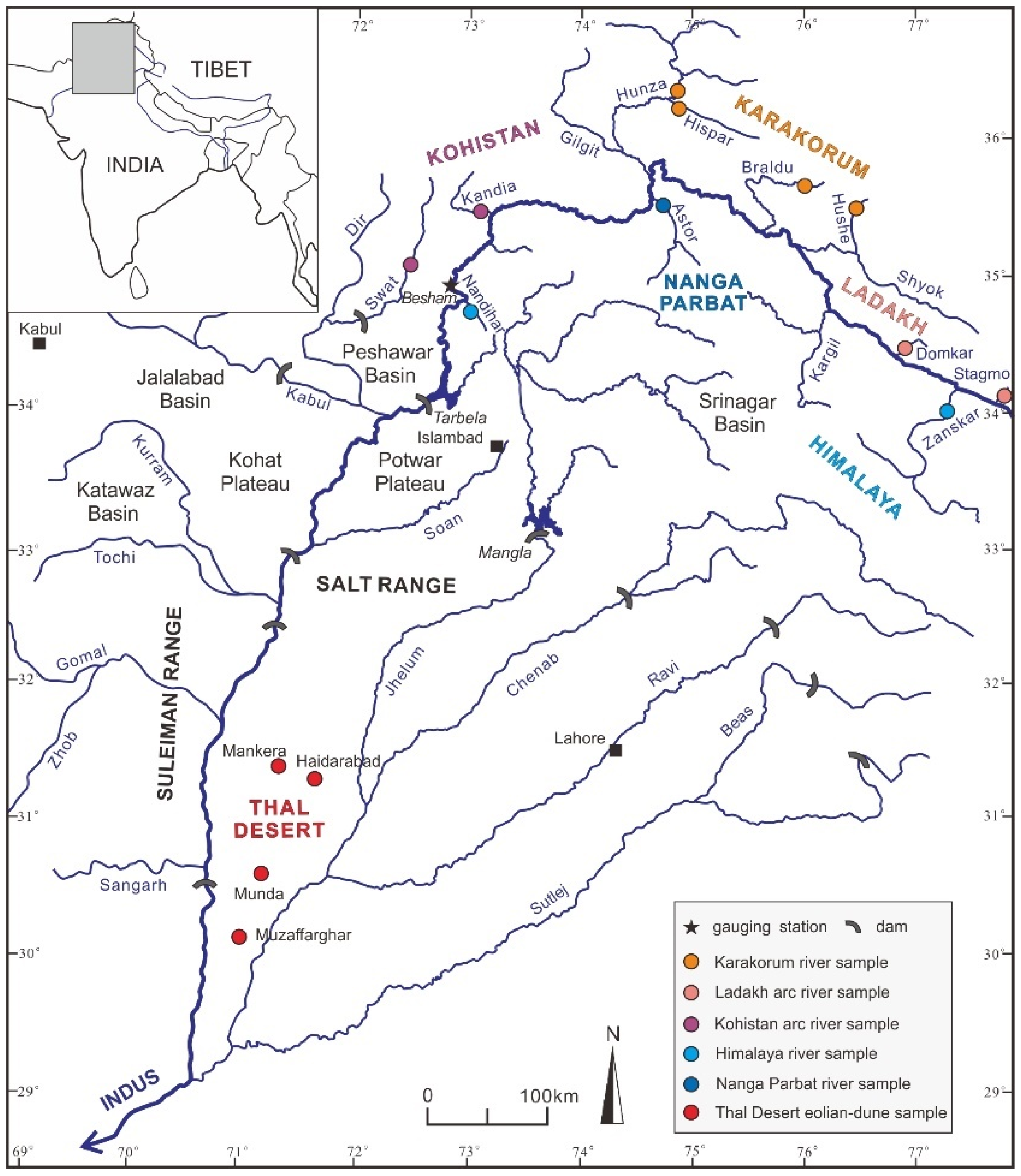
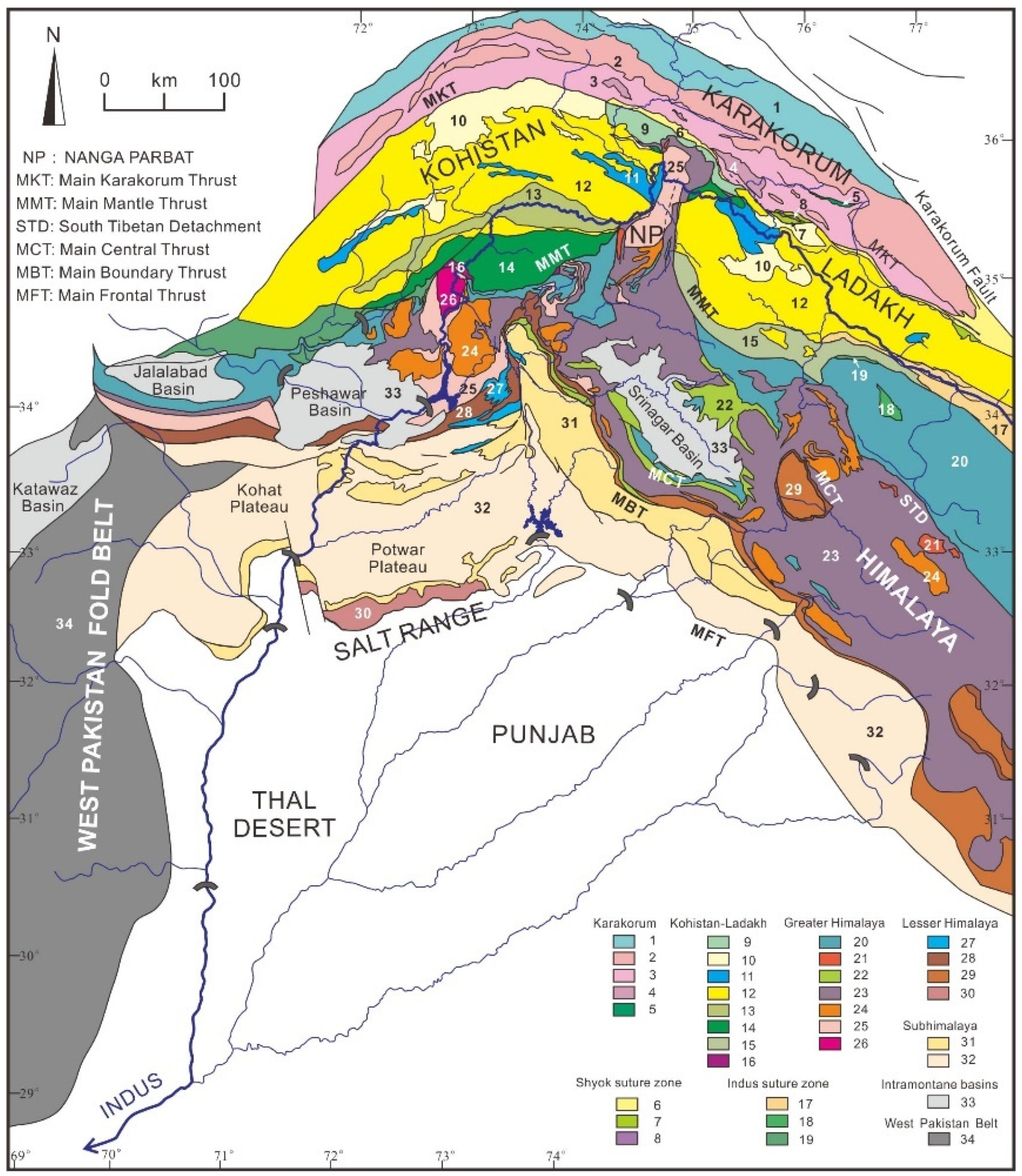
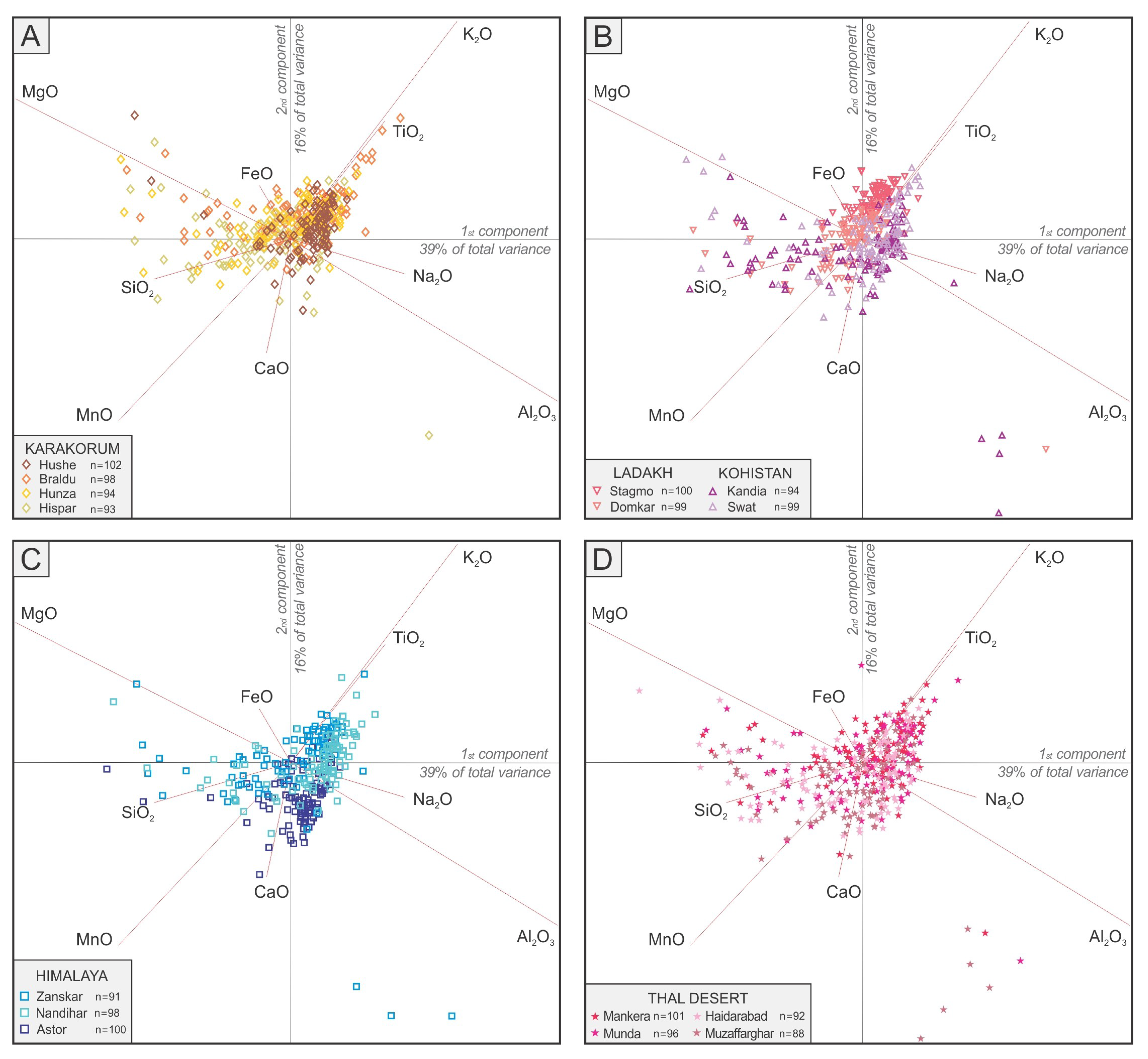
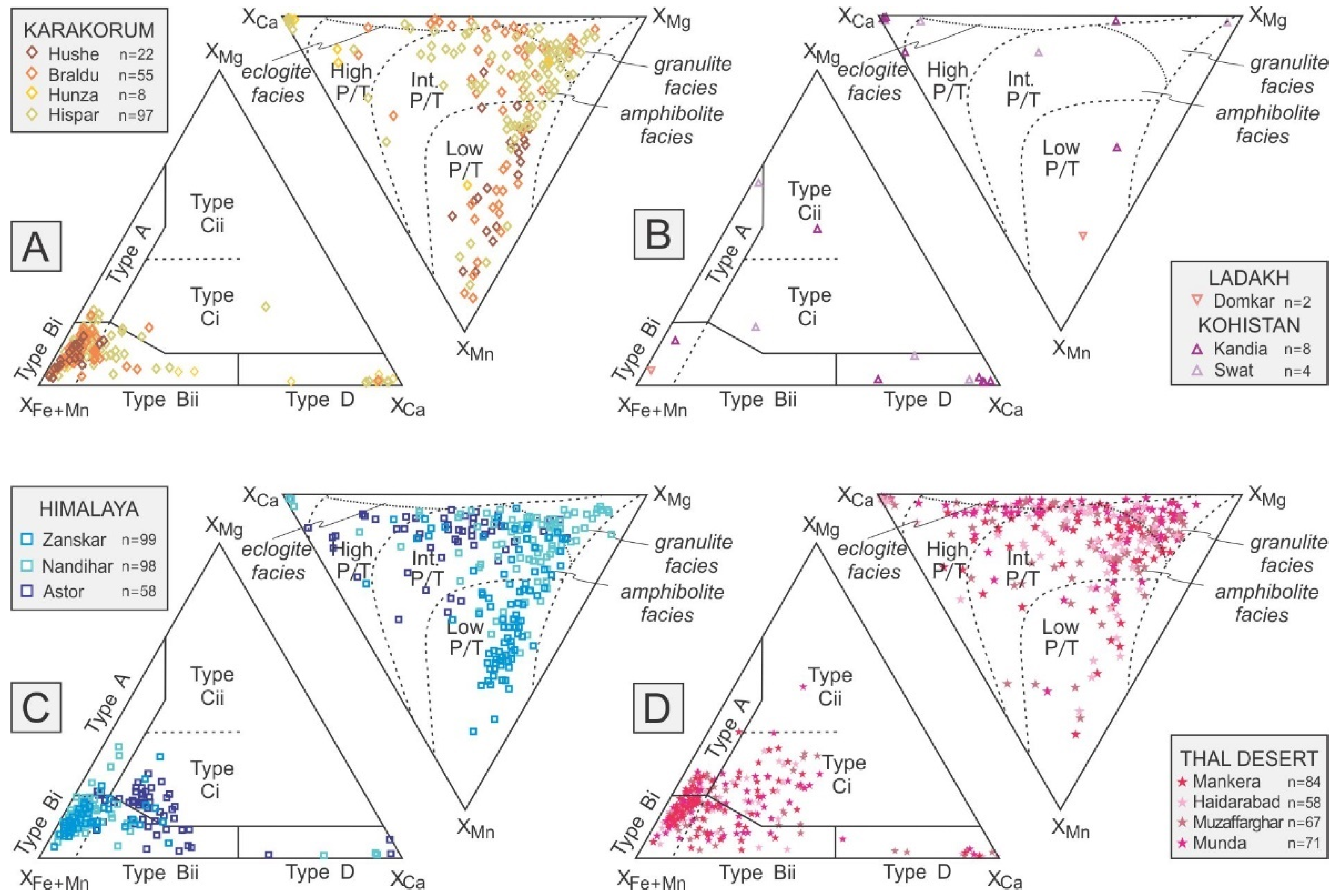
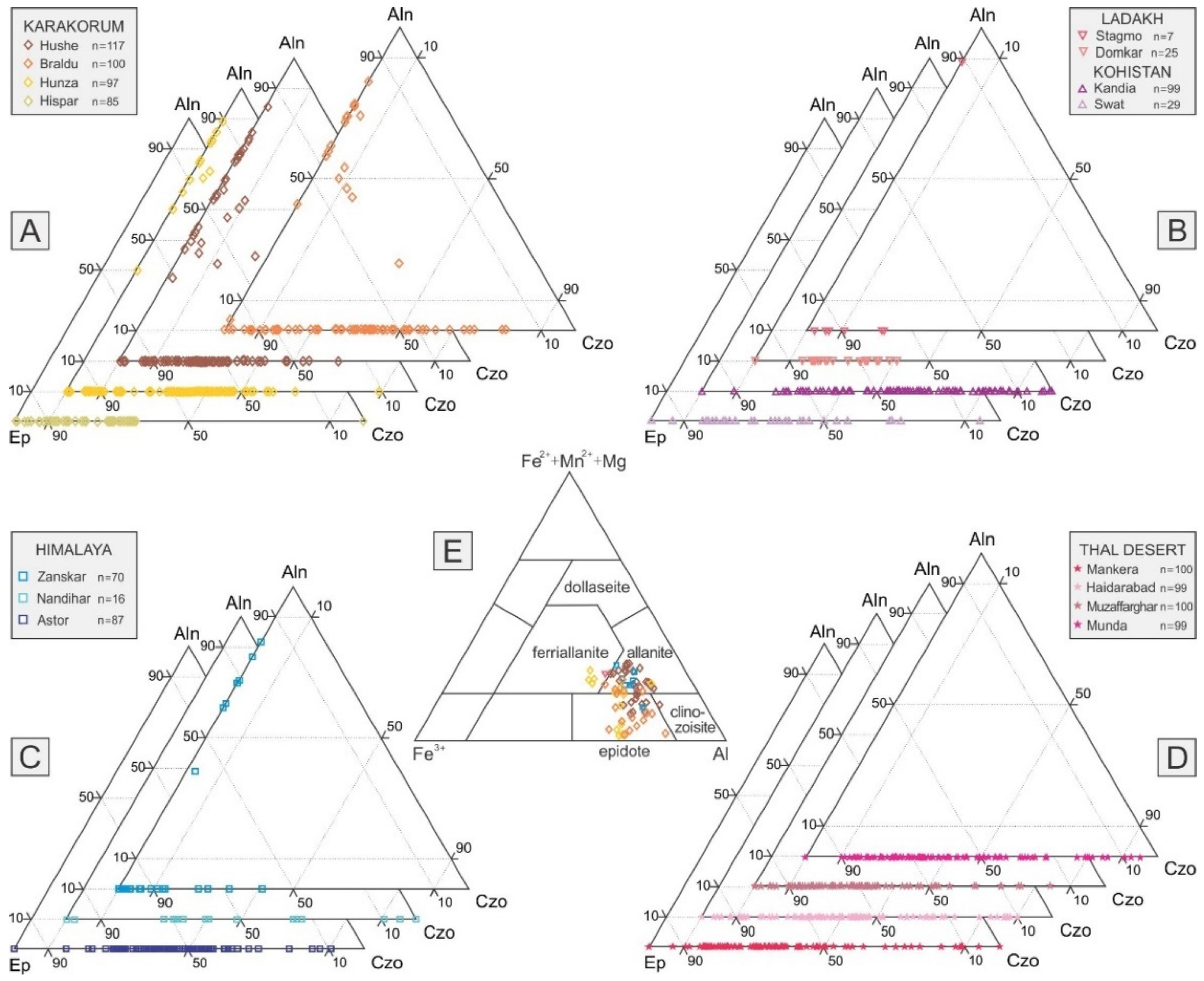
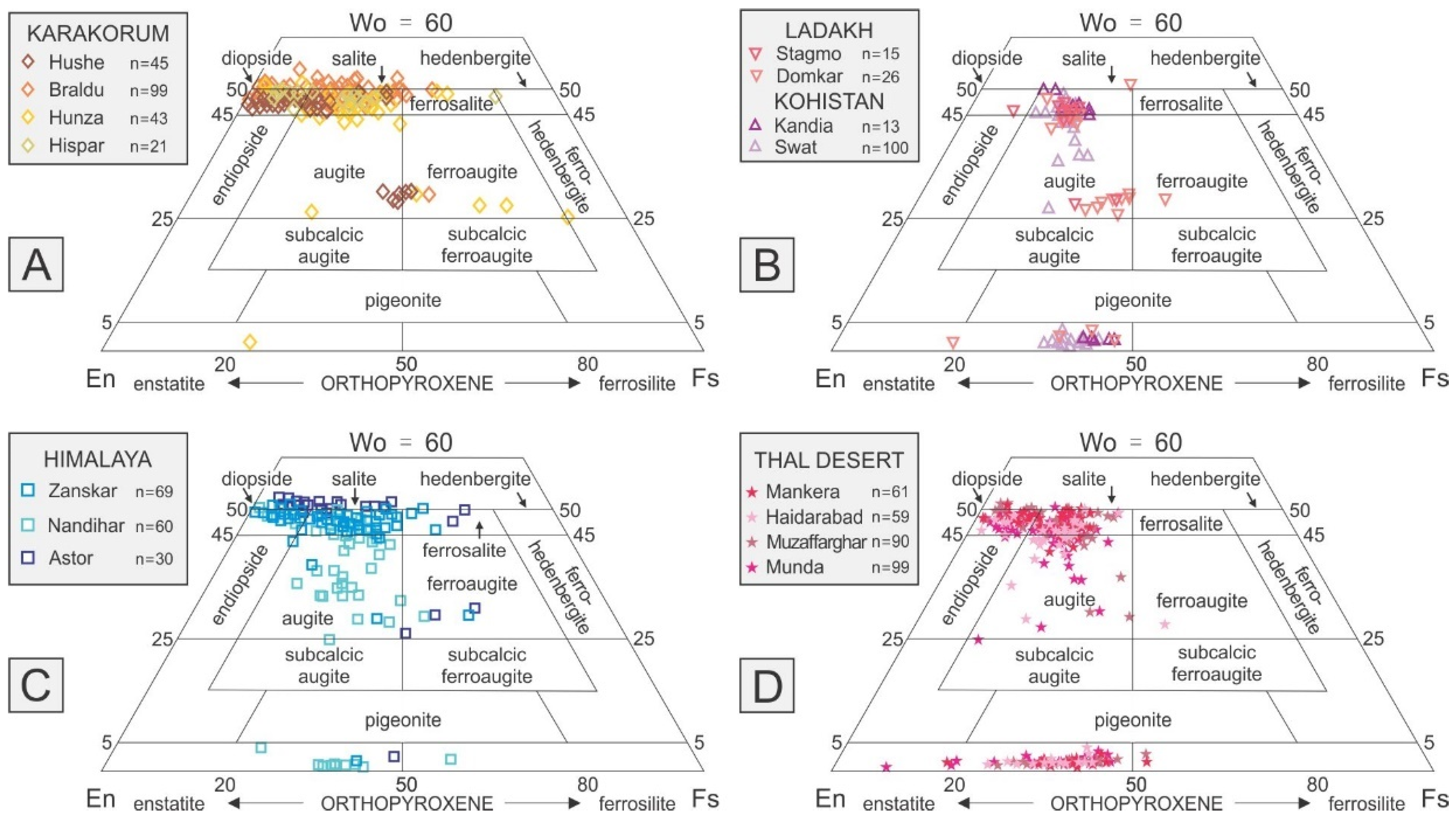

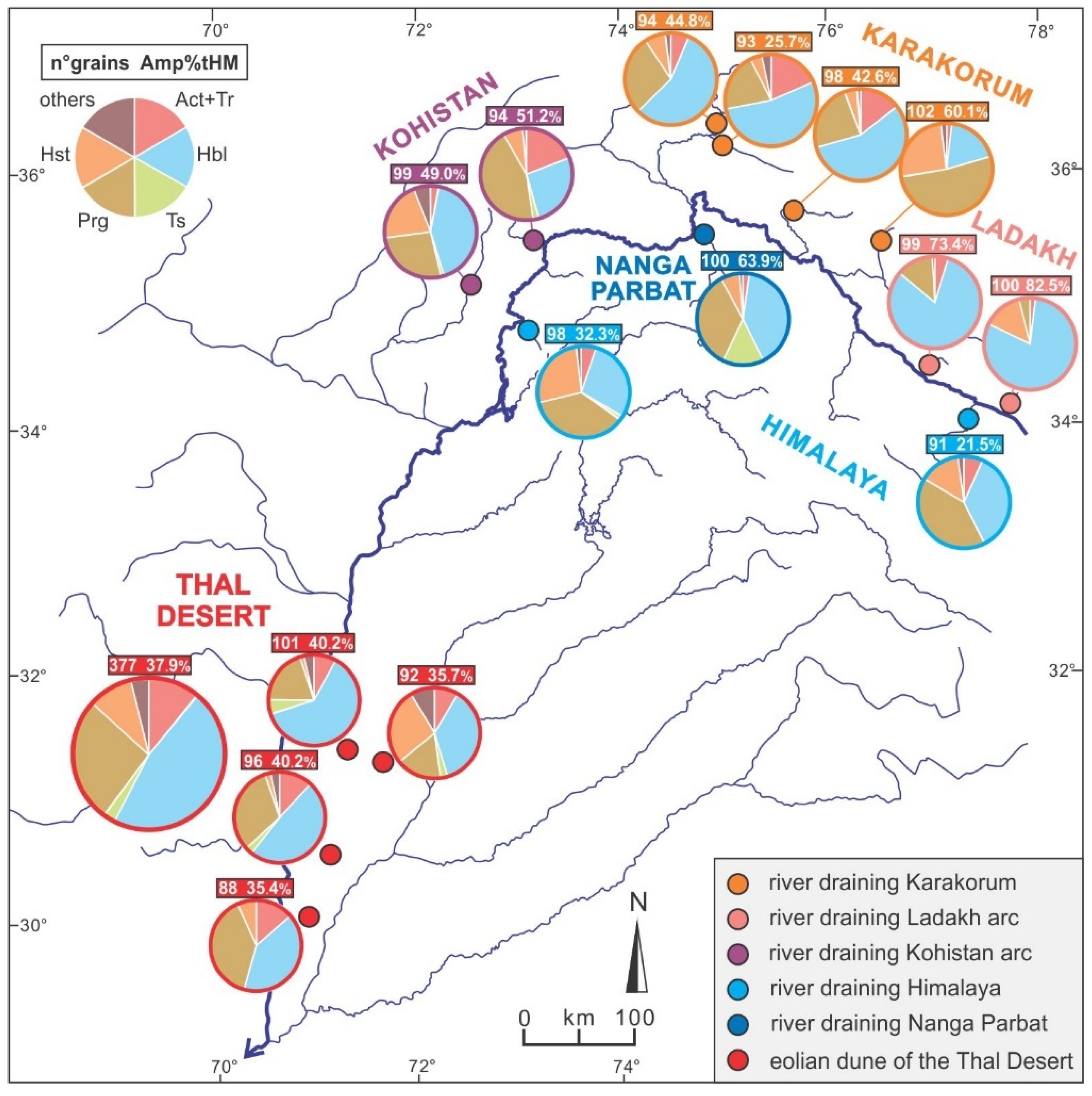
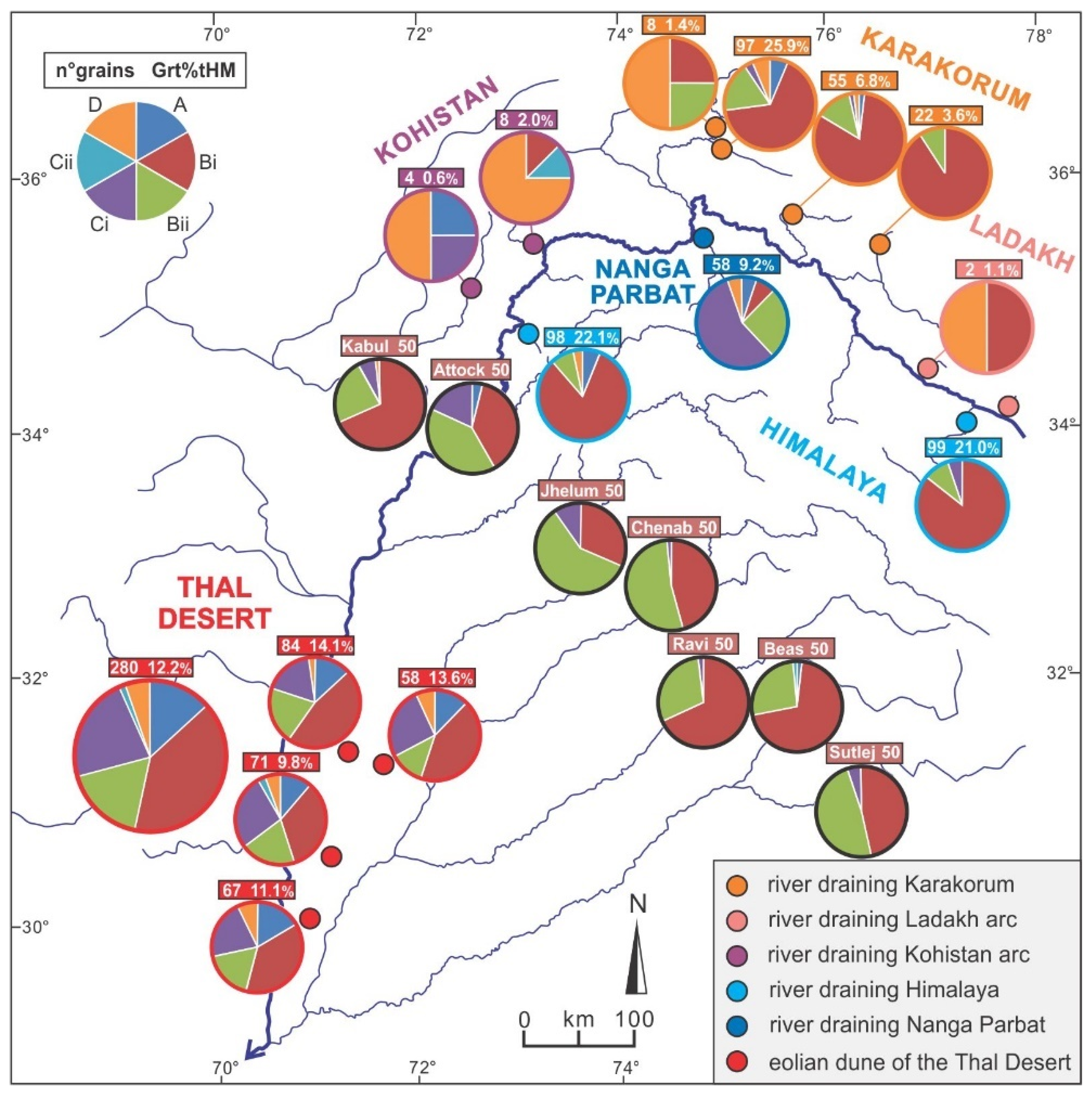

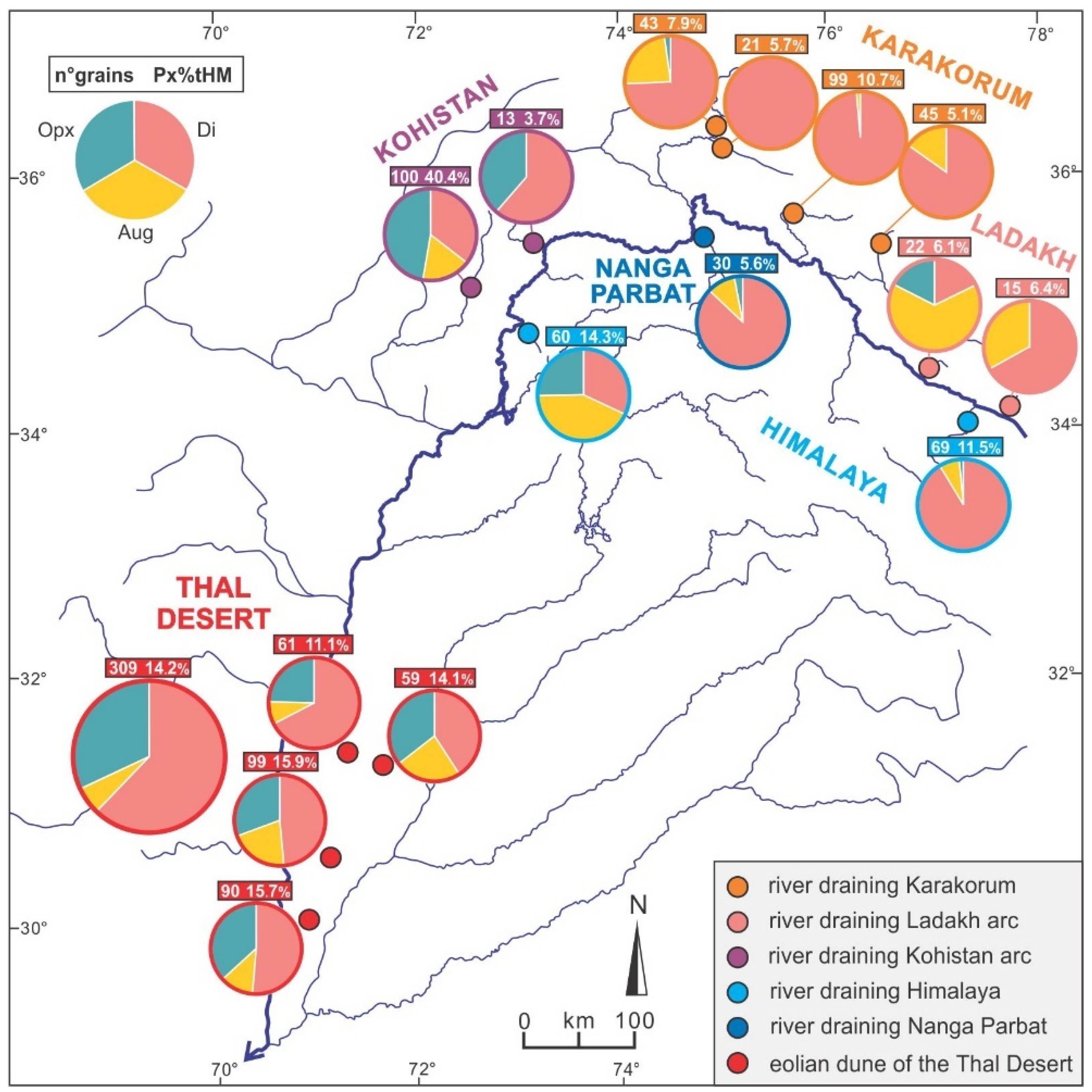
| Sample | River/Dune | Domain | HMC | tHMC | Zrn | Tur | Rt | Ttn | Ap | Amp | Cpx | Opx | Ol | Zo |
| S1749 | Hushe | Karakorum | 4.8 | 2.5 | 2 | 0.2 | 1 | 9 | 6 | 60 | 5 | 0 | 0.5 | 0 |
| S1748 | Braldu | Karakorum | 6.5 | 4.5 | 0.9 | 1 | 3 | 8 | 6 | 42 | 11 | 0 | 0.5 | 0.1 |
| S1437 | Hunza | Karakorum | 2.9 | 1.5 | 0.5 | 2 | 9 | 10 | 5 | 45 | 8 | 0.2 | 0 | 0.2 |
| S1438 | Hispar | Karakorum | 8.7 | 6.7 | 2 | 1 | 1 | 10 | 3 | 26 | 6 | 0 | 0.2 | 0 |
| S4426 | Stagmo | Ladakh arc | 12.6 | 12.0 | 0.4 | 0.4 | 0.4 | 6 | 0.9 | 82 | 6 | 0 | 0 | 0 |
| S4430 | Domkar | Ladakh arc | 9.7 | 8.1 | 2 | 0.3 | 1 | 7 | 1 | 73 | 6 | 0.3 | 0 | 0 |
| S1439 | Kandia | Kohistan arc | 44.2 | 33.4 | 0 | 0 | 0.5 | 7 | 0.5 | 51 | 4 | 0 | 0.2 | 2 |
| S1440 | Swat | Kohistan arc | 31.4 | 27.5 | 0.2 | 0 | 2 | 1 | 0.6 | 49 | 37 | 4 | 0 | 0 |
| S4419 | Zanskar | G. Himalaya | 4.8 | 4.6 | 1 | 5 | 2 | 8 | 8 | 21 | 11 | 0 | 0.2 | 0 |
| S1426 | Nandihar | G. Himalaya | 4.8 | 4.0 | 0.6 | 8 | 1 | 5 | 3 | 32 | 13 | 2 | 0 | 0.6 |
| S1432 | Astor | Nanga Parbat | 17.9 | 16.9 | 0.2 | 1 | 2 | 1 | 0.3 | 64 | 6 | 0 | 0.2 | 0.6 |
| S1462 | Mankera | Thal Desert | 21.2 | 15.3 | 0 | 1 | 1 | 4 | 0.3 | 40 | 10 | 1 | 0.5 | 0.5 |
| S1463 | Haidarabad | Thal Desert | 24.2 | 18.6 | 0 | 0.4 | 2 | 6 | 1 | 36 | 11 | 3 | 0.4 | 0.9 |
| S1470 | Muzaffarghar | Thal Desert | 26.4 | 17.7 | 0.3 | 0.8 | 2 | 4 | 1 | 35 | 13 | 2 | 1 | 0.7 |
| S1474 | Munda | Thal Desert | 12.3 | 10.0 | 0.3 | 1 | 1 | 4 | 1 | 40 | 13 | 2 | 0.3 | 0.3 |
| Sample | River/Dune | Domain | Czo | &Ep | Grt | Cld | St | And | Ky | Sil | &HM | Tot | %Amp | %Grt |
| S1749 | Hushe | Karakorum | 1 | 11 | 4 | 0 | 0 | 0 | 0 | 0.2 | 0.6 | 100.0 | 1.5 | 0.1 |
| S1748 | Braldu | Karakorum | 5 | 11 | 7 | 1 | 0.4 | 0.8 | 0 | 0.4 | 1 | 100.0 | 1.9 | 0.3 |
| S1437 | Hunza | Karakorum | 6 | 13 | 1 | 0 | 0.2 | 0.3 | 0 | 0 | 0.5 | 100.0 | 0.7 | 0.0 |
| S1438 | Hispar | Karakorum | 9 | 15 | 26 | 0.2 | 0.5 | 0 | 0 | 0 | 0.2 | 100.0 | 1.7 | 1.7 |
| S4426 | Stagmo | Ladakh arc | 0 | 3 | 0 | 0 | 0 | 0 | 0 | 0 | 0 | 100.0 | 9.9 | 0.0 |
| S4430 | Domkar | Ladakh arc | 0.5 | 7 | 1 | 0 | 0 | 0 | 0 | 0 | 0.8 | 100.0 | 5.9 | 0.1 |
| S1439 | Kandia | Kohistan arc | 22 | 10 | 2 | 0 | 0 | 0 | 0 | 0 | 0 | 100.0 | 17.1 | 0.7 |
| S1440 | Swat | Kohistan arc | 2 | 4 | 0.6 | 0 | 0 | 0 | 0 | 0 | 0 | 100.0 | 13.5 | 0.2 |
| S4419 | Zanskar | G. Himalaya | 0.3 | 11 | 21 | 0 | 0.3 | 0 | 0.5 | 9 | 1 | 100.0 | 1.0 | 1.0 |
| S1426 | Nandihar | G. Himalaya | 1 | 2 | 22 | 0 | 2 | 0 | 8 | 0.6 | 0.4 | 100.0 | 1.3 | 0.9 |
| S1432 | Astor | Nanga Parbat | 5 | 9 | 9 | 0 | 0.2 | 0.2 | 0.8 | 0.2 | 0.2 | 100.0 | 10.8 | 1.6 |
| S1462 | Mankera | Thal Desert | 15 | 9 | 14 | 0.3 | 0.8 | 0 | 1 | 0.2 | 0.7 | 100.0 | 6.1 | 2.1 |
| S1463 | Haidarabad | Thal Desert | 11 | 13 | 14 | 0 | 0.6 | 0.2 | 0.4 | 1 | 0 | 100.0 | 6.6 | 2.5 |
| S1470 | Muzaffarghar | Thal Desert | 14 | 11 | 11 | 0 | 0.5 | 0 | 0.8 | 0.5 | 0.5 | 100.0 | 6.3 | 2.0 |
| S1474 | Munda | Thal Desert | 11 | 12 | 10 | 0 | 0.6 | 0 | 1 | 0.3 | 0.1 | 100.0 | 4.0 | 1.0 |
© 2019 by the authors. Licensee MDPI, Basel, Switzerland. This article is an open access article distributed under the terms and conditions of the Creative Commons Attribution (CC BY) license (http://creativecommons.org/licenses/by/4.0/).
Share and Cite
Liang, W.; Garzanti, E.; Andò, S.; Gentile, P.; Resentini, A. Multimineral Fingerprinting of Transhimalayan and Himalayan Sources of Indus-Derived Thal Desert Sand (Central Pakistan). Minerals 2019, 9, 457. https://doi.org/10.3390/min9080457
Liang W, Garzanti E, Andò S, Gentile P, Resentini A. Multimineral Fingerprinting of Transhimalayan and Himalayan Sources of Indus-Derived Thal Desert Sand (Central Pakistan). Minerals. 2019; 9(8):457. https://doi.org/10.3390/min9080457
Chicago/Turabian StyleLiang, Wendong, Eduardo Garzanti, Sergio Andò, Paolo Gentile, and Alberto Resentini. 2019. "Multimineral Fingerprinting of Transhimalayan and Himalayan Sources of Indus-Derived Thal Desert Sand (Central Pakistan)" Minerals 9, no. 8: 457. https://doi.org/10.3390/min9080457
APA StyleLiang, W., Garzanti, E., Andò, S., Gentile, P., & Resentini, A. (2019). Multimineral Fingerprinting of Transhimalayan and Himalayan Sources of Indus-Derived Thal Desert Sand (Central Pakistan). Minerals, 9(8), 457. https://doi.org/10.3390/min9080457





